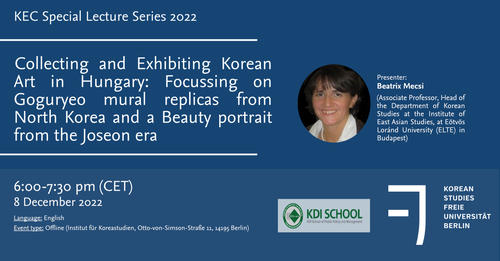KEC Special Lecture Series 2022 - Collecting and Preserving Korean Art in Europe
Presenter:
Beatrix Mecsi (Associate Professor, Head of the Department of Korean Studies at the Institute of East Asian Studies, at Eötvös Loránd University (ELTE) in Budapest)
Abstract:
Two different types of paintings will be introduced in the talk that ended up in the collection of the Ferenc Hopp Museum of Asian Art, Budapest. Through these objects we show the circumstances of their acquisition and the history of their reception. The first example is a group of life size copies of the wall paintings of the Anak 3 tomb from Goguryeo, commissioned by a Hungarian diplomat in North Korea in 1950s by contemporary North Korean painters, while the other is a rare standing woman portrait from the Joseon period which came to the museum from the private collection of the renown Hungarian architect and designer Lajos Kozma (1844-1948), who purchased it in Paris. This woman portrait is a type that until now only seven such woman portraits remained for us including Korea. It can be proved – by comparing it to a similar but dated painting coming from a Japanese private collection revealed in 2008 – that in the time of its creation the ideology of Neoconfucianism was all-pervasive and made the painters (whose names usually not known) use the well-accepted themes even when they wished to present beautiful ladies in a formal, bigger painting. (Normally beautiful ladies were represented on album leaves, a more intimate format.) When such a beauty portrait was chosen to be presented at the Paris World Exposition in 1900, it had a different meaning, showing Korean types of people and clothing. However, when this portrait was shown in Hungary in an exhibition in 1911, we can witness the impact of its artistic expressions on the artists active at the time of its arrival, more notably on the painter József Rippl-Rónai (1861-1927).
In the case of the copies of the 4th century Anak 3 tomb murals, we can see an interesting phenomenon: the copies begin to appear in foreign exhibitions. The idea of making copies of tomb murals stemmed from the colonial period, when the Japanese art historian Sekino Tadashi (1867-1935) promoted the production of replicas for study purposes of the art of the newly conquered territories. Later, North Koreans started to use them for their own political agenda, and especially the Anak 3 tomb paintings which played an important role by showing the everyday life of Goguryeo people. The interpretations emphasized that they were “Korean”, taking a firm position in the debate of their identity. Similar issues are raised by the revived interest in the Goguryeo mural replicas by South Korean scholars from the 2000s, again emphasizing the identity opposed to China's North Asia-policy, aiming for their role in preserving Korean Cultural heritage.
When such objects are shown in Hungary, far away from the place of their creation, they represent a culture, and – depending on the context of the exhibition – they can take on more and different aspects, enriching our views on Korea and revealing different receptions of its culture.
Zeit & Ort
08.12.2022 | 18:00 - 19:30
Offline:
Institut für Koreastudien
Otto-von-Simson-Str. 11
14195 Berlin
Weitere Informationen
Prof. Vladimir Glomb (vladous2000@yahoo.com)

